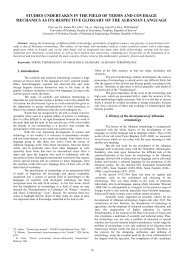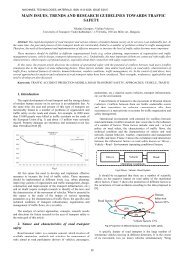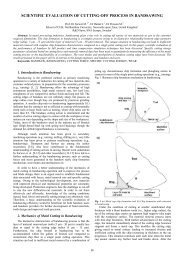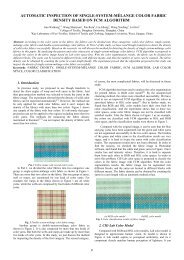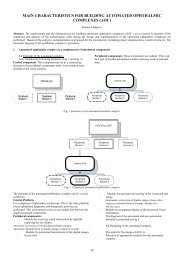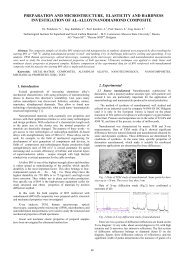the estimation of air pollution from road traffic by transport modeling
the estimation of air pollution from road traffic by transport modeling
the estimation of air pollution from road traffic by transport modeling
Create successful ePaper yourself
Turn your PDF publications into a flip-book with our unique Google optimized e-Paper software.
Vehicle fleet<br />
information<br />
Network<br />
Signal<br />
Wind speed<br />
and direction<br />
Traffic volume<br />
Simulation model<br />
<strong>of</strong> <strong>traffic</strong> flow at<br />
<strong>the</strong> microscopic level<br />
Time, instant speed, acceleration,<br />
position <strong>of</strong> each vehicle<br />
THE MODEL FOR<br />
EMISSIONS CALCULATION<br />
Concentration <strong>of</strong> pollutants<br />
at each receptor<br />
Vehicle's<br />
characteristics<br />
Emissions inventory at<br />
<strong>the</strong> microscopic level<br />
Receptor<br />
position<br />
Fig. 4 The structure <strong>of</strong> <strong>the</strong> microscopic model for estimating pollutant<br />
emissions <strong>from</strong> <strong>road</strong> <strong>traffic</strong>.<br />
4. Conclusions<br />
Air <strong>pollution</strong> is a consequence <strong>of</strong> human activities, including<br />
<strong>road</strong> vehicle use. Thus, <strong>transport</strong>, especially <strong>road</strong> <strong>traffic</strong>, is a major<br />
source <strong>of</strong> <strong>air</strong> <strong>pollution</strong> in most <strong>of</strong> <strong>the</strong> world. Road <strong>traffic</strong> associated<br />
<strong>air</strong> <strong>pollution</strong> comes mainly <strong>from</strong> burning fossil fuels.<br />
The general process <strong>of</strong> <strong>modeling</strong> <strong>air</strong> <strong>pollution</strong> generated <strong>by</strong> <strong>road</strong><br />
<strong>traffic</strong> consists <strong>of</strong> <strong>the</strong> following steps: (i) collecting data and<br />
information underlying <strong>the</strong> trips generation, (ii) estimating <strong>the</strong><br />
<strong>transport</strong> demand and <strong>the</strong> affecting <strong>of</strong> <strong>the</strong> <strong>traffic</strong> flows on <strong>the</strong> entire<br />
analyzed network and (iii) <strong>the</strong> inventory <strong>of</strong> <strong>the</strong> emissions <strong>from</strong> <strong>road</strong><br />
vehicles which compose <strong>the</strong> <strong>traffic</strong> flows.<br />
In <strong>the</strong> research in <strong>the</strong> field <strong>of</strong> <strong>transport</strong>, <strong>traffic</strong> flow<br />
representation was a key issue in <strong>modeling</strong> <strong>of</strong> <strong>air</strong> <strong>pollution</strong> <strong>from</strong><br />
<strong>road</strong> <strong>traffic</strong>. Currently, <strong>the</strong> most used models to represent <strong>traffic</strong><br />
flow are macroscopic models, which may show <strong>the</strong> average travel<br />
speed along a stretch <strong>of</strong> <strong>road</strong>. The data required in macroscopic<br />
<strong>modeling</strong> are moderate and can be easily applied to evaluate a wide<br />
range <strong>of</strong> <strong>transport</strong> strategies. But <strong>the</strong>se models are not able to reveal<br />
<strong>the</strong> local variations concerning <strong>air</strong> <strong>pollution</strong> in <strong>the</strong> vicinity <strong>of</strong><br />
intersections or in different <strong>traffic</strong> conditions. To overcome this<br />
shortcoming, mesoscopic models have been developed. Although<br />
<strong>the</strong>se are essentially based on a macroscopic representation <strong>of</strong><br />
<strong>traffic</strong> flows, <strong>the</strong>y can describe different modes <strong>of</strong> using vehicles<br />
such as acceleration, deceleration, cruising and queueing. As a<br />
result, <strong>the</strong> mesoscopic models may be useful in <strong>modeling</strong> <strong>air</strong><br />
<strong>pollution</strong> in <strong>the</strong> intersections area <strong>of</strong> influence. Therefore, special<br />
attention in <strong>the</strong> <strong>modeling</strong> <strong>of</strong> <strong>air</strong> <strong>pollution</strong> generated <strong>by</strong> <strong>road</strong> <strong>traffic</strong> is<br />
dedicated to developing models that are able to detail <strong>the</strong> <strong>traffic</strong><br />
flow characteristics, namely <strong>the</strong> microsimulation models. These<br />
models have <strong>the</strong> ability to characterize <strong>the</strong> movement <strong>of</strong> each<br />
vehicle in terms <strong>of</strong> developed instant speed and acceleration. The<br />
emissions associated with <strong>traffic</strong> flow are obtained <strong>by</strong> aggregating<br />
<strong>the</strong> specific vehicle emissions at <strong>the</strong> individual level.<br />
5. References<br />
1. Cohen, S., Use <strong>of</strong> <strong>traffic</strong> simulation in analysis <strong>of</strong> carbon<br />
monoxide <strong>pollution</strong>, Transport Research Record 648, Transportation<br />
Research Board, Washington DC., United States, 1977.<br />
2. Cohen, S., Euler, G., Signal cycle length and fuel<br />
consumption and emissions, Transportation Research Record 667,<br />
Transportation Research Board, Washington DC., United States,<br />
1978.<br />
63<br />
3. Datculescu, O., The evaluation <strong>of</strong> emission factors and <strong>traffic</strong><br />
measurements in <strong>the</strong> central area <strong>of</strong> <strong>the</strong> Bucharest Municipality,<br />
Romanian Auto Register, Bucharest, 2011.<br />
4. European Environment Agency (EEA), Emission Inventory<br />
Guidebook – Road Transport, European Environment Agency,<br />
2009.<br />
5. Hassounah, M.I., Miller, J., Modelling <strong>air</strong> <strong>pollution</strong> <strong>from</strong><br />
<strong>road</strong> <strong>traffic</strong>: a review, Traffic Engineering and Control, 1994.<br />
6. Horowitz, J., Air quality analysis for urban <strong>transport</strong>ation<br />
planning, MIT Press (Cambridge, Mass.), ISBN 0262081164, 1982.<br />
7. Kunselman, P., McAdams, H.T., Domke, M.E., Williams,<br />
M.E., Automobile exhaust emissions modal analysis model, Calspan<br />
Corporation, Buffalo, NY, Environmental Protection Agency,<br />
document No. 460/3-74-005, Office <strong>of</strong> Mobile Source Air Pollution<br />
Control, USA, 1974.<br />
8. Matzoros, A., Vliet, D., A model <strong>of</strong> <strong>air</strong> <strong>pollution</strong> <strong>from</strong> <strong>road</strong><br />
<strong>traffic</strong>, based on <strong>the</strong> characteristics <strong>of</strong> interrupted flow and junction<br />
control Part I & II, Transportation Research - A, 26 A (4), pp. 315<br />
~ 355, 1992.<br />
9. Mitran, G., The identification <strong>of</strong> major factors <strong>from</strong> <strong>road</strong><br />
<strong>traffic</strong> which produce <strong>the</strong> <strong>air</strong> <strong>pollution</strong> and <strong>the</strong> presentation <strong>of</strong> <strong>the</strong><br />
current stage <strong>of</strong> <strong>the</strong> research in <strong>road</strong> <strong>traffic</strong> <strong>modeling</strong> and <strong>air</strong><br />
<strong>pollution</strong> <strong>from</strong> <strong>road</strong> vehicles, PhD Scientific Report No. 1,<br />
University <strong>of</strong> Pitești, Romania, 2011.<br />
10. Ortuzar, J. de Dios, Willumsen, L., Modelling <strong>transport</strong>, 3 rd<br />
edition, John Wiley & Sons, London, 2001.<br />
11. Park, J. Y., Noland, R., Polak, J., Microscopic model <strong>of</strong> <strong>air</strong><br />
pollutant concentrations: comparison <strong>of</strong> simulated results with<br />
measured and macroscopic estimates, Transportation Research<br />
Record: Journal <strong>of</strong> <strong>the</strong> Transportation Research Board,<br />
Transportation Research Board <strong>of</strong> <strong>the</strong> National Academies, ISSN<br />
0361-1981, 2007.<br />
12. Popa, M., Elements <strong>of</strong> <strong>transport</strong> economics, Bren Publishing<br />
House, Bucharest, 2004.<br />
13. Taylor, M., Young T., Developing a set <strong>of</strong> fuel consumption<br />
and emissions models for use in <strong>traffic</strong> network modelling, 13 th<br />
International Symposium on Transportation and Traffic <strong>the</strong>ory,<br />
Lyon, France, 1996.<br />
14. United States Environmental Protection Agency (USEPA),<br />
Update <strong>of</strong> ambient water quality criteria for ammonia, Las Vegas,<br />
USA, 2000.<br />
Acknowledgment<br />
The preparation <strong>of</strong> Gabriela Mitran’s PhD program is funded <strong>by</strong><br />
grant doctorates <strong>from</strong> <strong>the</strong> Structural Funds <strong>of</strong> <strong>the</strong> financing contract<br />
AMPOSDRU: “Development <strong>of</strong> doctoral schools <strong>by</strong> providing<br />
scholarships for young PhD students” – ID 52826.



